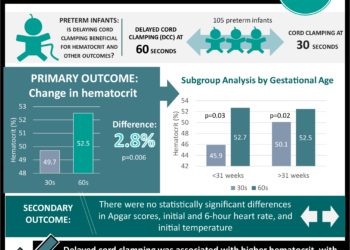Clinical prediction score predicts risk of neonatal rebound hyperbilirubinemia
1. A clinical prediction rule was developed to estimate the probability of rebound hyperbilirubinemia in newborns undergoing first-time inpatient phototherapy.
2. The strongest predictors of rebound hyperbilirubinemia were gestational age, age at phototherapy initiation, and relative total serum bilirubin (TSB) level at time of phototherapy termination
Evidence Rating: 2 (Good)
Study Rundown: The American Academy of Pediatrics (AAP) offers consensus guidelines for when to start phototherapy in neonates for hyperbilirubinemia, but there is no universal standard for when to discontinue phototherapy. In the current study, researchers developed and internally validated a clinical prediction rule for estimating the probability of rebound hyperbilirubinemia in newborns undergoing first-time inpatient phototherapy. Of the predictor variables evaluated, the highest clinical predictors of rebound hyperbilirubinemia were gestational age <38 weeks, younger age at initiation of phototherapy, and TSB relative to the AAP’s treatment initiation threshold at completion of phototherapy. Using the prediction rule, results indicated that infants with scores of <30 had a <10% probability of rebound hyperbilirubinemia, and infants with scores of <20 had a <4% risk of rebound hyperbilirubinemia. The researchers acknowledge several limitations in this study. First, the TSB at time of phototherapy termination was derived by extrapolation for the majority of infants in the study, reducing the discriminatory ability of the score. Second, the study is limited to infants who have rebound hyperbilirubinemia after only their first inpatient course of phototherapy. Overall, this study offers an internally validated score for predicting rebound hyperbilirubinemia that may enhance a clinician’s ability to avoid the risks of a prolonged treatment versus the risks of rebound hyperbilirubinemia.
Click to read the study, published today in Pediatrics.
Relevant Reading: Management of hyperbilirubinemia in the newborn infants 35 or more weeks of gestation.
In-Depth [retrospective cohort]: A total of 7048 infants ≥35 weeks’ gestational age undergoing first-time inpatient phototherapy before 14 days of life were evaluated. The primary outcome assessed was rebound hyperbilirubinemia, defined as a TSB at or above the AAP phototherapy threshold within 72 hours of completing phototherapy, requiring return to treatment. In this cohort, 324 (4.6%) infants had rebound hyperbilirubinemia. The authors then derived a clinical prediction rule for assessing the probability of rebound hyperbilirubinemia using a split sample approach – using half of the cohort to derive the rule and the other half to internally validate it. To derive the rule, the authors combined the highest predictor variables of gestational age, age at phototherapy initiation (as a continuous variable, OR=0.51; 95%CI=0.38-0.58, log coefficient=-0.68) and TSB at phototherapy termination (OR=1.5; 95%CI=1.4-1.7; log coefficient=0.42) into the following equation: “Score = 15 (if gestational age <38 weeks) – 7 x (age in days at phototherapy initiation) – 4 x (AAP phototherapy threshold – TSB at phototherapy termination) + 50.” AUC values representing the accuracy of identifying the probability of rebound hyperbilirubinemia were good in both the derivation sub-cohort (n=3518; AUC=0.89; 95%=0.86-0.91) and validation sub-cohort (n=3530; AUC=0.88; 95%CI=0.86-0.90).
Image: PD
©2017 2 Minute Medicine, Inc. All rights reserved. No works may be reproduced without expressed written consent from 2 Minute Medicine, Inc. Inquire about licensing here. No article should be construed as medical advice and is not intended as such by the authors or by 2 Minute Medicine, Inc.






